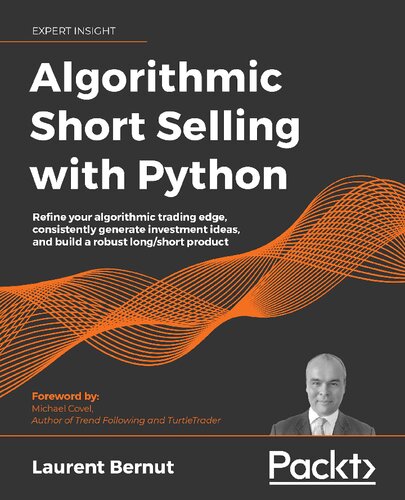دانلود کتاب Algorithmic Short-Selling with Python: Refine your algorithmic trading edge, consistently generate investment ideas, and build a robust long/short product - Original PDF
Author:
Laurent Bernut
0 (0)
توضیحات کتاب :
Leverage Python source code to revolutionize your short selling strategy and to consistently make profits in bull, bear, and sideways markets Key Features • Understand techniques such as trend following, mean reversion, position sizing, and risk management in a short-selling context • Implement Python source code to explore and develop your own investment strategy • Test your trading strategies to limit risk and increase profits Book Description If you are in the long/short business, learning how to sell short is not a choice. Short selling is the key to raising assets when the markets are down. This book will help you demystify and rehabilitate the short-selling craft, providing Python source code to construct a robust long/short portfolio. It explains everything you have ever read about short selling from a long-only perspective. This book will take you on a journey from an idea (“buy bullish stocks, sell bearish ones”) to becoming part of the elite club of long/short hedge fund algorithmic traders. You’ll explore key concepts such as trading psychology, trading edge, regime definition, signal processing, position sizing, risk management, and asset allocation, one obstacle at a time. Along the way, you’ll will discover simple methods to consistently generate investment ideas, and consider variables that impact returns, volatility, and overall attractiveness of returns. By the end of this book, you’ll not only become familiar with some of the most sophisticated concepts in capital markets, but also have Python source code to construct a long/short product that investors are bound to find attractive. What you will learn • Develop the mindset required to win the infinite, complex, random game called the stock market • Demystify short selling in order to make consistent profits from bull, bear, and sideways markets • Generate ideas consistently on both sides of the portfolio • Implement Python source code to engineer a statistically robust trading edge • Perform superior risk management for high returns • Build a long/short product that investors will find appealing Who This Book Is For This is a book by a practitioner for practitioners. It is designed to benefit a wide range of people, including long/short market participants, quantitative participants, proprietary traders, commodity trading advisors, retail investors (pro retailers, students, and retail quants), and long-only investors. At least 2 years of active trading experience, intermediate-level experience of the Python programming language, and basic mathematical literacy (basic statistics and algebra) are expected
سرچ در وردکت | سرچ در گودریدز | سرچ در اب بوکز | سرچ در آمازون | سرچ در گوگل بوک
1,526 بازدید 1 خرید










